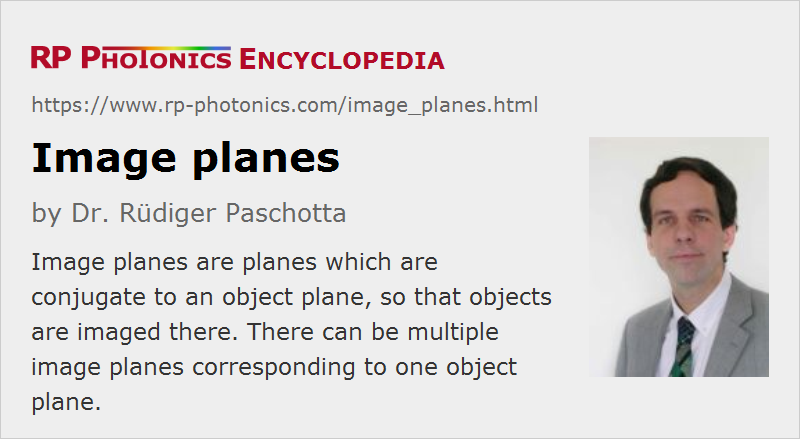Image Planes
Definition: planes which are conjugate to an object plane, so that objects are imaged there
German: Bildebenen
Categories: general optics, vision, displays and imaging
How to cite the article; suggest additional literature
Author: Dr. Rüdiger Paschotta
When analyzing the imaging properties of an optical instrument such as a telescope, photo camera or a microscope, one often considers the imaging of object points lying in a plane perpendicular to the optical axis, called the object plane. An image plane is then a plane in which a sharp image of those object points appears, at least within Gaussian optics. In reality, one will not obtain sharp image points due to diffraction and optical aberrations, which are not considered in the context of Gaussian optics. For example, the actual points with best sharpness generally lie on a more or less curved surface (field curvature), not in a plane. So the concept of an image plane is only an approximation.
The object and image plane are conjugate planes. When the position of the object plane is modified (e.g. by longitudinal movements of objects), the location of the image plane changes as well; the amount of that change can be calculated using the longitudinal magnification.
In some situations, there is not only an object and a single image plane, but multiple image planes, because the imaging occurs in more than one step. There is then a final image plane, where one may place an image sensor, for example, and in addition some intermediate image planes. In a microscope, for example, there is often such an intermediate image plane just before the ocular lens; the ocular can be considered to image that plane to infinity, and the lens of the observer's eye can image that to the retina.
In some instruments, and additional elements such as a reticle is placed in an intermediate image plane. This is then also sharply imaged into the final image plane. This is useful for measurement microscopes and telescopes, for example. However, one often avoids placing elements in intermediate image claims which should not be imaged. For example, it could be detrimental to have the optical surface of a prism or a lens in an intermediate image plane, because otherwise any scratches or dust particles would also appear in the final image. However, one sometimes places a field lens there; this should then have a particularly clean surface.
Image planes should not be confused with focal planes. They coincide with those only for objects at infinite distance.
Questions and Comments from Users
Here you can submit questions and comments. As far as they get accepted by the author, they will appear above this paragraph together with the author’s answer. The author will decide on acceptance based on certain criteria. Essentially, the issue must be of sufficiently broad interest.
Please do not enter personal data here; we would otherwise delete it soon. (See also our privacy declaration.) If you wish to receive personal feedback or consultancy from the author, please contact him e.g. via e-mail.
By submitting the information, you give your consent to the potential publication of your inputs on our website according to our rules. (If you later retract your consent, we will delete those inputs.) As your inputs are first reviewed by the author, they may be published with some delay.
See also: imaging, imaging with a lens, Gaussian optics, conjugate planes
and other articles in the categories general optics, vision, displays and imaging
 |






If you like this page, please share the link with your friends and colleagues, e.g. via social media:
These sharing buttons are implemented in a privacy-friendly way!